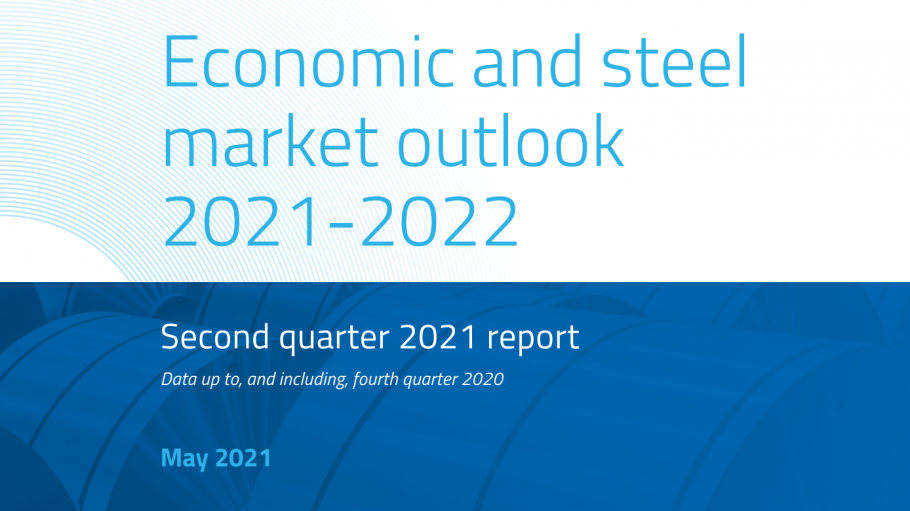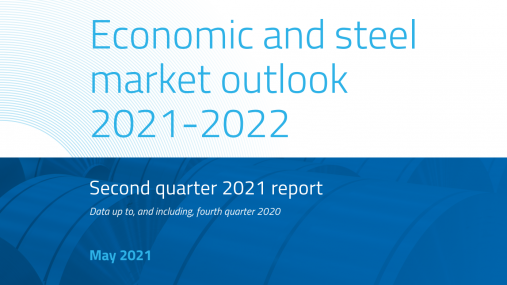
Publications » Economic and market outlook » Economic and steel market outlook 2021-2022, second quarter
Economic and steel market outlook 2021-2022, second quarter
Downloads and links
Recent updates

In 2020, the COVID-19 pandemic slashed steel consumption and the overall economic outlook across the EU and the world. Shutdown measures, implemented by governments from March 2020, severely impacted manufacturing activity and steel-using industrial sectors.
However, some of the measures that had the greatest impact on the economy were loosened as of June 2020, though many social measures remain in effect or have been reinforced in recent months. As a result, both steel-using sectoral output and steel demand experienced a considerable quarter-on-quarter rebound over the third and the fourth quarter.
Although the general economic recovery in the EU appears to be uneven and exposed to risks, the recovery in steel-using industries and in steel demand should continue through 2021.
EU steel market overview
The whole year 2020 was, as expected, considerably impacted by the pandemic and saw apparent steel consumption in the EU plummet (-11.1%). It is set to rebound (+11.7%) in 2021, and to grow more moderately (+4.9%) in 2022, when it is expected to return above 2017 levels thanks to continued improvement in demand from steel-using sectors.
EU28 apparent steel consumption increased (+3.3%) year-on-year in the fourth quarter of 2020, that is the first quarterly growth since the fourth quarter of 2019, after the drop (-10.4%) recorded over the third consecutive quarter (that followed the unprecedented drop (-25%) in the second quarter). Apparent steel consumption in the fourth quarter amounted to 35.2 million tonnes.
Mirroring the improvement in demand, domestic deliveries in the EU in the fourth quarter of 2020 increased (+4.5%, after -6.8% recorded in the second quarter).
Data for the fourth quarter also showed the continued downturn in imports from third countries. After the severe drop (-25%) in the third quarter of 2020, imports from third countries dropped – albeit less severely - also in the fourth quarter of 2020, with a year-on-year fall (-7%), that is the eighth consecutive quarterly drop.
EU steel-using sectors
Total production activity in steel-using sectors fell (-10.4%) over the full year 2020.
The second quarter saw a sharp fall in steel-using industrial output (-25%), linked to industrial stoppages caused by the COVID pandemic. The third quarter also saw a decline (-6.7%) as did the fourth quarter (-1.9%). This is the fifth consecutive quarterly decline.
The COVID-19 outbreak further hit EU industrial sectors at a time when these had already been experiencing a severe downturn and were coping with serious challenges. Over the course of 2019, business conditions in the manufacturing industry had continued to deteriorate.
This downward trend gained speed in the second half of 2019, particularly in the automotive industry. This resulted in a pronounced slowdown in output growth in steel-using sectors, which then culminated in unprecedented drops over the second quarter 2020, mainly as a result of the severe lockdown measures imposed by governments in March and April 2020.
The second quarter marked the trough of the industrial recession. The loosening of lockdown measures over the third quarter allowed industrial activity to restart, with a considerable rebound in output compared to the record lows seen in the preceding quarter. However, industrial activity remained around low levels in historical terms and still exposed to fragility and risks. As a result, despite the quarter-on -quarter rebound, output fell year-on-year (-6.7%) in the third quarter.
The fresh wave of the pandemic that hit Europe at the start of the fourth quarter 2020 led to new lockdowns (albeit without affecting industrial activity per se) which cast a shadow on the overall recovery. As a result, however, in the fourth quarter of 2020 industrial output all over the EU recorded a considerable second consecutive quarter-on-quarter rebound, driven by faster-than-expected recovery in output in some sectors (domestic appliances and automotive in particular).
Steel-using sectors’ output growth over the fourth quarter was still negative (-1.9%), i.e. the fifth consecutive quarterly drop, but at a much lower rate than the third quarter (-6.7%). This could pave the way for a stronger acceleration in industrial recovery over the first quarter of 2021, despite persistent economic uncertainty due the ongoing pandemic across the EU.

Download this publication or visit associated links
A milestone occasion to quickly and effectively restore affordable electricity, to relaunch the
decarbonization and strengthen the international competitiveness of the European steel
industry.
Brussels, 02 December 2025 – Unchanged negative conditions – U.S. tariffs and trade disruptions, economic and geopolitical tensions, protracted weak demand and still high energy prices – continue to weigh on the European steel market. EUROFER’s latest Economic and Steel Market Outlook confirms for 2025 another recession in both apparent steel consumption (-0.2%, unchanged) and steel-using sectors (-0.5%, revised from -0.7%). A potential recovery is expected only in 2026 for the Steel Weighted Industrial Production index (SWIP) (+1.8%, stable) and for apparent steel consumption (+3%, slightly revised from +3.1%) – although consumption volumes would still remain well below pre-pandemic levels. Steel imports retained historically high shares (27%), while exports plummeted (-9%) in the first eight months of 2025.
Fourth quarter 2025 report. Data up to, and including, second quarter 2025